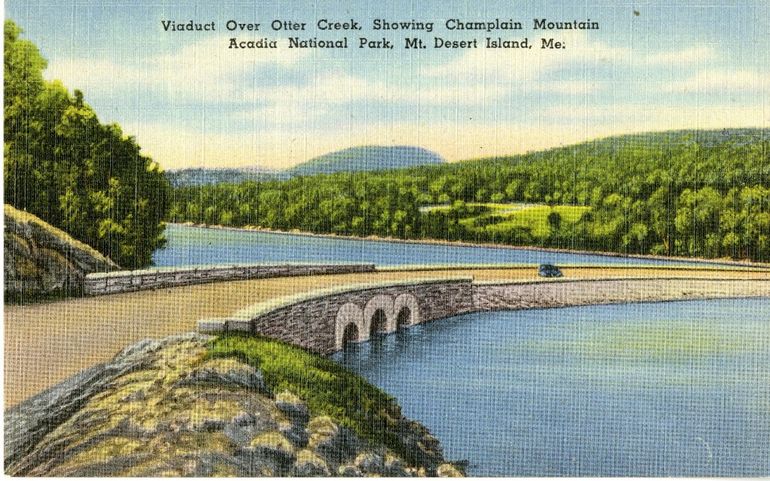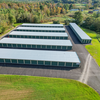A village on Mount Desert Island looks to restore health of harbor
 Courtesy / Karen Zimmerman, National Park Service
Otter Creek Cove Causeway shown on a 1940s postcard shortly after its construction. The causeway separates the cove into an inner harbor and outer cove. The inner harbor, formerly the site of a vibrant fishing community, sits in the background. The causeway is a part of the Loop Road through Acadia National Park.
Courtesy / Karen Zimmerman, National Park Service
Otter Creek Cove Causeway shown on a 1940s postcard shortly after its construction. The causeway separates the cove into an inner harbor and outer cove. The inner harbor, formerly the site of a vibrant fishing community, sits in the background. The causeway is a part of the Loop Road through Acadia National Park.
Residents of a tiny but scenic village on Mount Desert Island are looking to restore the health of a local cove to re-establish fishing, clamming, recreation and other traditional uses.
Otter Creek is south of Bar Harbor on the eastern side of Mount Desert Island. Half of it is in the town of Mount Desert and half is owned by Bar Harbor. But geographically, it’s surrounded by Acadia National Park.
“For many years, community members who live around and use Otter Creek Cove have been concerned about declines in the health of the inner harbor, indicated by marked declines in populations of fish, clams, and other organisms,” says a project statement by Thriving Earth Exchange, a Washington, D.C., nonprofit that promotes community science.
The nonprofit is working with the town of Mount Desert and Acadia to assess the health of the inner harbor and research the cause of problems that might be affecting the water’s health and options to remediate problems.
According to the statement, “Assessing the Health of Otter Creek Inner Harbor and Potential Pathways to Remediate Problems,” problems “appear to be related to climate change, tidal restrictions caused by a causeway built in 1939, and contamination caused by a water treatment facility that dumped contaminated effluent into the inner harbor.”
The village is named after a creek that leads to Otter Cove, which lies on Mount Desert Island’s southern edge. The cove is traversed by Acadia’s Park Loop Road via a causeway that creates an inner and an outer harbor.
The town of Mount Desert and the town’s sustainability committee are leading the project. Mount Desert is a rural community with a population of 2,100 that covers the middle third of Mount Desert Island and includes six villages.
Otter Creek Cove is a central feature of the village of Otter Creek.
But with “National Park Service ownership of nearly all of the land around Otter Creek Cove and declines in the health of the inner harbor, community use of the cove has declined dramatically,” the statement says.
Part of the problem, the statement says, may be due to a causeway across the cove that restricts tidal flow to the inner harbor. The Maine Department of Environmental Protection and U.S. Environmental Protection Agency have documented that effluent from a water treatment facility in Otter Creek “contained heavy metals, including copper, zinc and cyanide, at concentrations that exceeded maximum regulatory limits.”
The goal is to determine why there have been “dramatic declines” in populations of fish, clams and other marine organisms in the inner harbor and to take steps that could improve its health.
The project started about a year ago with site visits, interviews with residents and scientists familiar with cove conditions and history, and assessment of existing data describing inner harbor conditions, Chris Petersen — a professor at Bar Harbor’s College of the Atlantic whose specialties include marine biology, and chair of Bar Harbor’s Marine Resources Committee — told the Bar Harbor Town Council earlier this month.
Petersen is a consulting scientist on the project and its Bar Harbor liaison.
Petersen said that, through the 18th and 19th centuries, Otter Creek was a vibrant farming and fishing community. That changed in the early 20th century, when land around it was acquired by the federal government during the early formation of what became Acadia National Park.
The federal government also built the causeway that splits the harbor and restricts tidal flow, possibly one of the causes of the cove’s loss of biodiversity, he noted.
Petersen said he and Hannah Webber, director of marine ecology at the Schoodic Institute, a scientific research nonprofit in Winter Harbor, were brought into the project from the start as consulting scientists.
Two community meetings were held last fall to discuss the community’s concerns, he said.
The two consultants have been developing a roadmap for working on the issues, he said.
But the pathways are complicated, he added. For example, the disappearance of clams could be related to the causeway’s presence. Or it could be related to larger, global issues such as ocean acidification.
“So it’s hard to decipher what’s being caused by global and regional changes and what things can change at the local level,” Petersen said.
Potential next steps could include further studies to document tidal flows, contaminants and experimental restoration of clam populations, followed by larger-scale remediation.













0 Comments